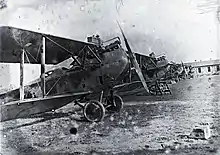Ufag C.I
The UFAG C.I was a military reconnaissance aircraft produced in the Austro-Hungarian Empire during World War I, by the Ungarische Flugzeugfabrik Abteil Gesellschaft (UFAG) . It was introduced in April 1918, and was widely used on the Italian Front in the final months of World War I.[1][2]
| UFAG C.I | |
|---|---|
.jpg.webp) | |
| An UFAG C.I(Ph) (series 123) built by Phönix Flugzeugwerke under license | |
| Role | Reconnaissance aircraft |
| National origin | Austria-Hungary |
| Manufacturer | UFAG |
| First flight | April 1918 |
| Introduction | 1918 |
| Primary user | KuKLFT |
| Number built | 250 |
| Developed from | Brandenburg C.II(U) |
The UFAG C.I incorporated the best features of the Brandenburg C.II(U) with single-bay wings and 'I' strut inter-plane bracing, which was replaced wing conventional steel-tube interplane struts in production aircraft. More manoeuvrable than the Phönix C.I, the C.I had good performance, but suffered from a few odd handling characteristics.[1][2]

Production of the C.I continued after the Armistice by MARE and was also built by the Neuschloss-Lichtig factory as the NL Sportplane.[2]
Variants
Data from:Austro-Hungarian Army Aircraft of World War One[2]
- UFAG 161.01
- First prototype 8.92 m (29.3 ft) span, 200 hp (150 kW) Hiero 6, 'I' type inter-plane struts.
- UFAG 161.02
- Second prototype, 230 hp (170 kW) Hiero 6, 'I' type inter-plane struts.
- UFAG C.I
- (series 161.03 to 161.22) Production by Ufag, 9.12 m (29.9 ft) span, 230 hp (170 kW) Hiero 6, twin inter-plane struts.
- UFAG C.I
- (series 161.31 to 161.250) Production by Ufag, 9.5 m (31 ft) span, 230 hp (170 kW) Hiero 6, twin inter-plane struts.
- UFAG C.I(Ph)
- (series 123.01 to 123.40) Production by Phönix, 9.12 m (29.9 ft) span, 230 hp (170 kW) Hiero 6, twin inter-plane struts.
- UFAG 60.01
- an improved C.I which would evolve into the UFAG 60.03 / C.II.
Operational history
The C.I was widely used by the KuKLFT on the Italian front by at least 30 Fliks. The C.I was also used post WWI by the Hungarian Red Airborne Corps as well as the clandestine Hungarian Legügyi Hivatal.[2] Ex-military C.Is were also converted for civil use and as mailplanes.
- Royal Yugoslav Air Force - Postwar.
- Romanian Air Corps - 20 UFAG C.I captured from the Hungarian Soviet Republic in 1919.[3]
Specifications (C.I second series 161.23 - 161.250)
Data from Austro-Hungarian Army Aircraft of World War One,[2] An Illustrated Guide to World Military Aircraft, 1914-2000[1]
General characteristics
- Crew: 2
- Length: 7.41 m (24 ft 4 in)
- Upper wingspan: 9.5 m (31 ft 2 in)
- Lower wingspan: 9.4 m (30 ft 10 in)
- Height: 2.7 m (8 ft 10 in)
- Wing area: 26.3 m2 (283 sq ft)
- Empty weight: 750 kg (1,653 lb)
- Gross weight: 1,150 kg (2,535 lb)
- Powerplant: 1 × Hiero 6 water-cooled in-line piston engine, 170 kW (230 hp)
- Propellers: 2-bladed wooden fixed-pitch propeller
Performance
- Maximum speed: 190 km/h (120 mph, 100 kn)
- Range: 350 km (220 mi, 190 nmi)
- Endurance: 3 hours
- Service ceiling: 4,900 m (16,100 ft)
Armament
- Guns: 1 x 8 mm (0.315 in) Schwarzlose machine-gun forward-firing fixed machine guns; 1 x 8 mm (0.315 in) Schwarzlose machine-gun in trainable rear cockpit mounting
- Bombs: 12 x 12 kg (26 lb) bombs (161.131 onwards)
References
- Fredricksen, John C. (2001). International warbirds: an illustrated guide to world military aircraft, 1914-2000. Santa Barbara, California: ABC-CLIO. ISBN 1-57607-364-5.
- Grosz, Peter M. (2002). Austro-Hungarian Army Aircraft of World War One. Colorado: Flying Machine Press. pp. 290–295.
- Alexandru Armă; Valeriu Avram (2017). Aeronautica română în Războiul de Întregire naţională 1916-1919 (in Romanian).